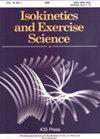Roux-en-Y胃旁路术后中长期妇女肌肉力量和质量与功能表现的关系
IF 0.7
4区 医学
Q4 ENGINEERING, BIOMEDICAL
引用次数: 0
摘要
背景:减肥手术后通常会出现肌肉质量和力量下降的情况,这可能会对个人的身体功能产生负面影响。肌肉质量在不同人群中也具有功能相关性,但其在减肥手术患者中的重要性还有待探索。目的:研究鲁-恩-Y 胃成形术(RYGB)后中长期女性肌肉力量和质量与身体功能之间的关系。方法:在这项横断面研究中,共纳入了 133 名女性(43.7± 9.9 岁),她们在研究前至少两年接受过 RYGB 术。所有参与者都接受了使用 DEXA 进行的身体成分评估和使用等速测力计进行的膝关节伸肌峰值力矩(PM)评估。肌肉质量(MQ)通过PM绝对值与优势腿部无脂肪质量之间的比率得出。身体功能通过 30 秒坐立(30-STS)、6 分钟步行(6-MWT)和定时起立行走(TUG)测试进行测量。结果:在 30-STS 和 6-MWT 测试中观察到 PM tertiles 之间存在差异。然而,在对年龄进行调整后,统计学意义消失了。至于 PM 相对于体重,所有功能测试在不同分层之间均有显著差异。根据 MQ 分层比较功能表现,发现 30-STS 和 6-MWT 测试存在差异,但在调整年龄后,差异不明显。绝对 PM 与 30-STS 性能和 6-MWT 相关,而相对于体重和 MQ 的 PM 则与所有功能测试相关。结论:肌肉力量和质量似乎与 RYGB 术后中长期女性的身体功能有关,但相对于体重的力量优于绝对力量和 MQ。本文章由计算机程序翻译,如有差异,请以英文原文为准。
The relationship between muscle strength and quality with functional performance in women mid- to long-term after Roux-en-Y gastric bypass
BACKGROUND: The reduction of muscle mass and strength commonly observed after bariatric surgery might negatively affect the individual physical function. Muscle quality is also of functional relevance in different populations, but its significance in patients who underwent bariatric surgery has yetto be explored. OBJECTIVE: To examine the association between muscle strength and quality with physical function in women mid- to long-term after Roux-en-Y gastroplasty (RYGB). METHODS: In this cross-sectional study, 133 women (43.7± 9.9 years) who have undergone RYGB at least two years before the study were included. All participants underwent body composition evaluation using DEXA and knee extensors peak moment (PM) using an isokinetic dynamometer. Muscle quality (MQ) was obtained through the ratio between absolute PM and dominant leg fat-free mass. Physical function was measured through the 30-second sit-to-stand (30-STS), 6-minute walking (6-MWT), and timed up-and-go (TUG) tests. RESULTS: Differences between PM tertiles were observed for 30-STS and 6-MWT tests. However, statistical significance disappeared when adjusting for age. Regarding PM relative to body weight, all functional tests were significantly different between tertiles. Comparing functional performance according to MQ tertiles, differences were found for 30-STS and 6-MWT tests, but significance disappeared when adjusting for age. Absolute PM was correlated to the 30-STS performance and 6-MWT, while PM relative to body mass and MQ were correlated with all functional tests. CONCLUSIONS: Muscle strength and quality seem to be associated with physical function in women mid-to-long-term after RYGB, but strength relative to bodyweight outperformed absolute strength and MQ.
求助全文
通过发布文献求助,成功后即可免费获取论文全文。
去求助
来源期刊

Isokinetics and Exercise Science
医学-工程:生物医学
CiteScore
1.20
自引率
14.30%
发文量
37
审稿时长
>12 weeks
期刊介绍:
Isokinetics and Exercise Science (IES) is an international journal devoted to the study of theoretical and applied aspects of human muscle performance. Since isokinetic dynamometry constitutes the major tool in this area, the journal takes a particular interest in exploring the considerable potential of this technology.
IES publishes studies associated with the methodology of muscle performance especially with respect to the issues of reproducibility and validity of testing, description of normal and pathological mechanical parameters which are derivable from muscle testing, applications in basic research topics such as motor learning paradigms and electromyography. The journal also publishes studies on applications in clinical settings and technical aspects of the various measurement systems employed in human muscle performance research.
The journal welcomes submissions in the form of research papers, reviews, case studies and technical reports from professionals in the fields of sports medicine, orthopaedic and neurological rehabilitation and exercise physiology.
 求助内容:
求助内容: 应助结果提醒方式:
应助结果提醒方式:


